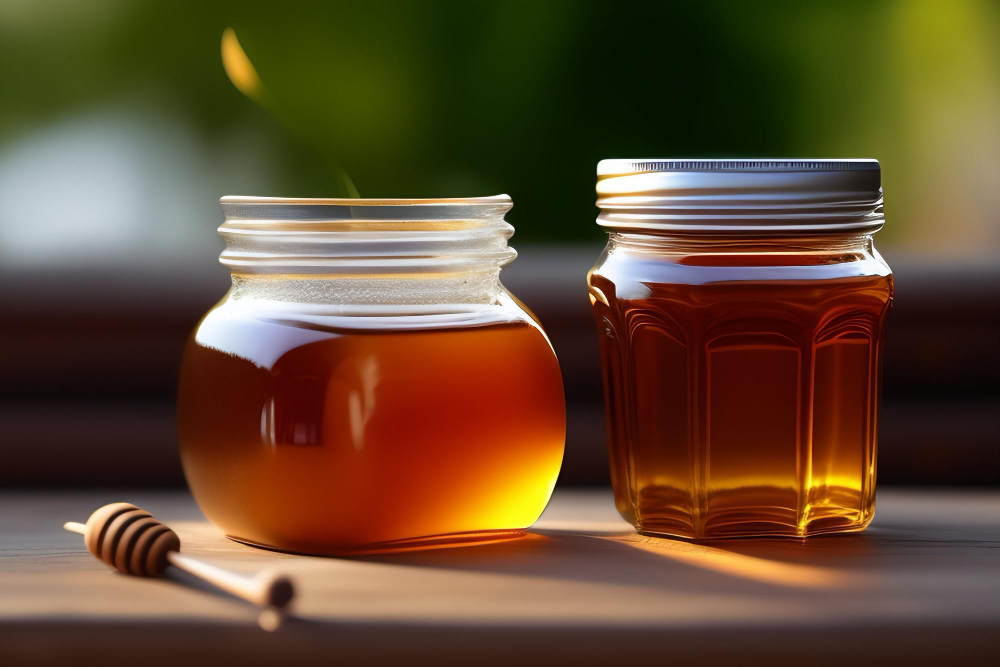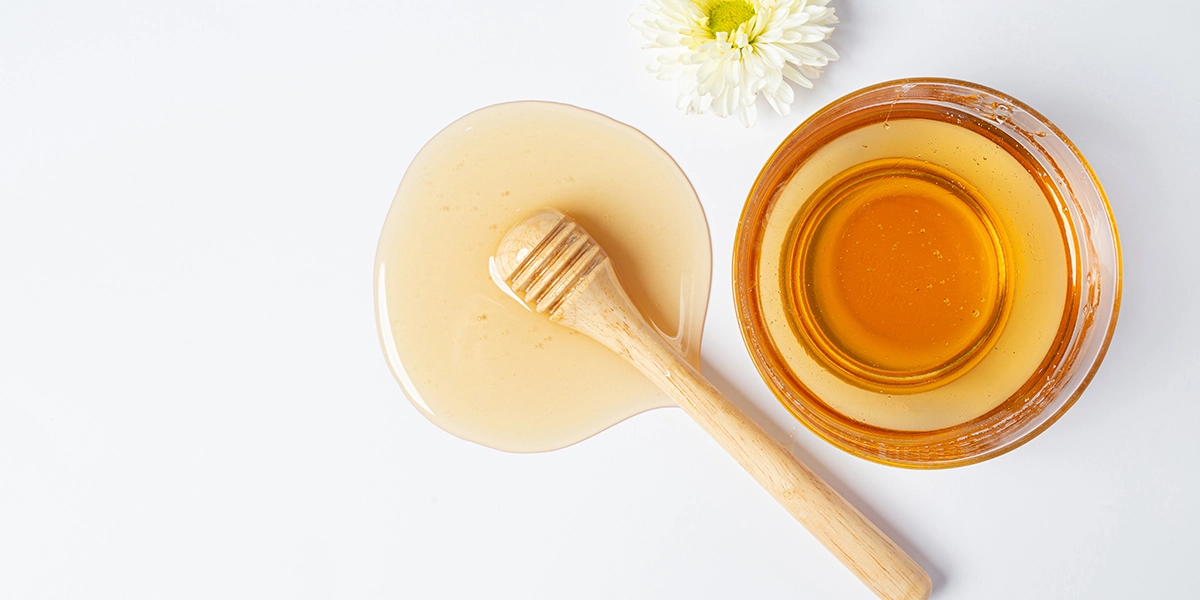Everything Honey is a sweet, viscous substance produced by bees primarily from the nectar of flowers. It has been used by humans for thousands of years as a natural sweetener and for its various health benefits.
Honey is a remarkable food because of its unique composition and properties.
Here are some key aspects of honey:
- Production: Honey is produced by honey bees through a process of collecting nectar from flowers. The bees store the nectar in their honeycombs and then fan it with their wings to evaporate excess water, transforming it into thick, concentrated honey.
- Composition: Honey is composed mainly of sugars, with fructose and glucose being the primary types. The exact composition of honey varies depending on the floral source, climate, and region where the bees collect the nectar.
- Floral Varieties: The flavor, aroma, and color of honey can differ based on the types of flowers from which the bees collected the nectar. Common floral varieties include clover, wildflower, orange blossom, and acacia, among others.
- Health Benefits: Honey is often considered a healthier alternative to refined sugar. It contains small amounts of vitamins, minerals, and antioxidants, though the levels can vary depending on the type of honey. Some of the potential health benefits of honey include soothing a sore throat, aiding in wound healing when applied topically, and providing some relief for coughs and colds.
- Medical Uses: Honey has been used historically for its medicinal properties in various cultures. It has antimicrobial properties, which may help in treating minor skin infections and wounds. However, it is essential to note that honey should not be given to infants under one year old due to the risk of infant botulism.
- Culinary Uses: Honey is a versatile ingredient in the kitchen and is used in various recipes, such as desserts, sauces, marinades, and beverages. Its unique flavor can enhance the taste of dishes.
- Crystallization: Over time, honey may undergo crystallization, becoming thicker and grainy in texture. This is a natural process and does not indicate spoilage. Crystallized honey can be liquefied by gently heating it in a warm water bath.
- Storage: Honey has a long shelf life and does not spoil easily due to its low water content and acidic pH. It is best stored in a sealed container at room temperature, away from direct sunlight.
- Beekeeping: Beekeepers are individuals who manage beehives to produce honey. They play a vital role in pollination and agriculture by helping to ensure the health of bee populations.
It’s important to note that while honey offers some health benefits, it is still a sweetener with high sugar content, so it should be consumed in moderation. Additionally, individuals with allergies to bee products should avoid honey, and it is not suitable for infants under one year old.
Honey has been used for centuries as both a natural sweetener and a traditional remedy for various health issues. It offers a range of potential health benefits, although it’s essential to remember that individual responses may vary. Here are some of the well-known health benefits of honey:
- Rich in Nutrients: Honey contains essential vitamins, minerals, and antioxidants, including vitamin C, calcium, potassium, iron, and various phytonutrients, depending on the type of honey.
- Antioxidant Properties: The antioxidants in honey help combat oxidative stress and reduce cellular damage caused by free radicals in the body, potentially reducing the risk of chronic diseases.
- Wound Healing: Honey possesses natural antibacterial properties and has been used topically for wound healing for centuries. It can help promote the healing of burns, cuts, and other minor wounds.
- Soothing Sore Throat and Cough: Honey has natural antimicrobial properties and can help soothe a sore throat and alleviate cough symptoms. Mixing honey with warm water or tea is a common home remedy for these conditions.
- Cough Suppressant: Honey has been found to be an effective and natural cough suppressant, particularly in children. It can help reduce the frequency and severity of coughing, allowing for better rest.
- Boosts Immune System: The antioxidants and antimicrobial properties of honey can contribute to strengthening the immune system, helping the body defend against infections.
- Digestive Health: Honey may aid in digestion and soothe gastrointestinal issues due to its potential prebiotic properties, promoting the growth of beneficial gut bacteria.
- Energy Source: The natural sugars in honey provide a quick source of energy, making it a popular choice for athletes and individuals needing a rapid energy boost.
- Potential Allergy Relief: Some studies suggest that consuming local raw honey may help alleviate allergy symptoms by exposing the body to small amounts of local pollen, which could potentially desensitize the immune system.
- Skin Care: When used topically, honey can moisturize and nourish the skin, making it a common ingredient in skincare products.
It’s important to note that while honey offers these potential benefits, it is still a form of sugar and should be consumed in moderation. Additionally, children under one year of age should not be given honey due to the risk of infant botulism, a rare but severe form of food poisoning. As with any natural remedy, it’s always a good idea to consult with a healthcare professional before using honey for specific health purposes, especially if you have allergies or medical conditions.
Uses of Honey
Honey is a versatile natural product with various uses, making it a popular ingredient in cooking, home remedies, and skincare routines. Here are some of the common uses of honey:
- Natural Sweetener: One of the most common uses of honey is as a natural sweetener in food and beverages. It can be used as a healthier alternative to refined sugar, adding a unique flavor to recipes.
- Home Remedies: Honey has been used for centuries in traditional medicine for its potential healing properties. It can be mixed with various ingredients to create remedies for sore throat, cough, wounds, and skin conditions.
- Sore Throat Relief: Honey’s soothing and antibacterial properties can help ease a sore throat. Mixing honey with warm water or herbal tea can provide relief from irritation and discomfort.
- Cough Suppressant: Honey’s natural cough-suppressant properties can be beneficial in reducing coughing and promoting better sleep. Mixing honey with lemon juice or warm water is a common home remedy for coughs.
- Wound Healing: When applied topically, honey’s antibacterial properties can aid in wound healing. It has been used for centuries to treat minor cuts, burns, and abrasions.
- Skincare: Honey’s moisturizing and nourishing properties make it a popular ingredient in skincare products. It can be used in face masks, scrubs, and moisturizers to help hydrate and soothe the skin.
- Energy Boost: The natural sugars in honey provide a quick source of energy. It is often consumed by athletes or individuals needing an energy boost before physical activities.
- Preserving Fruits: Honey’s natural preservative properties can be used to preserve fruits. It has been historically used for preserving certain fruits like figs.
- Sweetening Beverages: Honey can be used to sweeten various beverages, such as tea, smoothies, and cocktails, adding a unique flavor profile to the drinks.
- Baking: Honey can be used in baking as a substitute for sugar. It adds moisture and imparts a distinct taste to baked goods like cookies, cakes, and muffins.
- Marinades and Glazes: Honey’s sweetness and caramelization properties make it an excellent ingredient for marinades and glazes for meats, poultry, and fish.
- Face Cleanser: Honey can be used as a gentle face cleanser. Its antimicrobial properties can help cleanse the skin and remove impurities.
- Hair Conditioner: When mixed with other natural ingredients, honey can act as a hair conditioner, helping to moisturize and soften the hair.
- Allergy Relief (Caution Required): Some people believe that consuming local raw honey may provide relief from seasonal allergies by exposing the body to small amounts of local pollen. However, scientific evidence supporting this claim is limited, and caution should be exercised, especially if you have allergies or medical conditions.
Remember that while honey has numerous potential uses and benefits, it is still a form of sugar and should be consumed in moderation. Additionally, if you plan to use honey for specific health or skincare purposes, it’s a good idea to consult with a healthcare professional or dermatologist.
 Properties of Honey
Properties of Honey
Honey is a complex natural substance with a wide range of properties that make it unique and versatile.
Here are some of the key properties of honey:
- Sweetness: Honey is primarily known for its sweet taste due to its high sugar content. The main sugars in honey are fructose and glucose, which give it its characteristic sweetness.
- Viscosity: Honey has a thick and sticky consistency. Its viscosity can vary depending on the type of honey and its moisture content.
- Hygroscopic: Honey is hygroscopic, which means it has the ability to attract and hold water molecules from the surrounding environment. This property helps to keep honey moist and prevents the growth of microorganisms.
- Natural Preservative: Honey has natural preservative properties, mainly due to its low water content and acidic pH. These factors inhibit the growth of bacteria and other microorganisms, allowing honey to have a long shelf life.
- Antibacterial and Antimicrobial: Honey contains natural antibacterial properties, primarily attributed to its low water activity and the presence of hydrogen peroxide. It has been used historically as a topical agent for wound healing and fighting infections.
- Antioxidant: Honey contains various antioxidants, such as flavonoids and phenolic compounds, which help neutralize free radicals and reduce oxidative stress in the body.
- pH Balance: Honey is acidic, with a pH ranging between 3.2 and 4.5, depending on the type and origin. This acidity contributes to its preservative and antibacterial properties.
- Nutrient-Rich: Honey contains small amounts of vitamins and minerals, including vitamin C, calcium, iron, potassium, and various B vitamins.
- Floral Flavors and Aromas: The taste and aroma of honey can vary significantly based on the nectar source from which bees collect the honey. Different flowers impart distinct flavors and scents to the honey.
- Crystallization: Honey is prone to crystallization, especially when stored at cooler temperatures. This natural process does not affect the quality of honey and can be reversed by gently heating the honey.
- Anti-inflammatory: Some studies suggest that certain compounds in honey may have anti-inflammatory effects, which could be beneficial for various health conditions.
- Low Water Activity: Honey has low water activity, meaning it contains very little free water. This property makes honey inhospitable to most bacteria and microorganisms, contributing to its preservation capabilities.
It’s important to note that the properties of honey can vary depending on factors such as the floral source, geographical location, and processing methods. Raw honey, which is minimally processed and unheated, tends to retain more of its natural properties compared to commercial pasteurized honey. As a natural product, honey offers several potential health benefits, but it should be consumed in moderation, like any other sweetener, due to its high sugar content.
Nutrition Facts about Honey
The nutritional composition of honey can vary depending on factors such as the type of honey, the floral source, and its processing. Generally, honey is composed mainly of carbohydrates, primarily in the form of sugars.
Here are the approximate nutrition facts for 1 tablespoon (21 grams) of honey:
- Calories: 64
- Total Carbohydrates: 17 grams
- Sugars: 16 grams (mainly fructose and glucose)
- Other Carbohydrates: 1 gram (in the form of complex carbohydrates and fibers)
- Total Fat: 0 grams
- Protein: 0 grams
- Fiber: 0 grams
- Vitamins and Minerals: Honey contains small amounts of vitamins and minerals, including vitamin C, calcium, iron, potassium, and various B vitamins. However, the quantities are generally too low to have a significant impact on daily nutrient intake.
It’s important to note that honey is a concentrated source of sugar and calories, and it lacks significant amounts of other essential nutrients like protein, fiber, and fats. While honey does contain some antioxidants and beneficial compounds, its primary nutritional value comes from its sweetening properties.
As with any sweetener, honey should be consumed in moderation as part of a balanced diet. People with diabetes or those looking to manage their sugar intake should be particularly cautious with their honey consumption. Additionally, infants under one year of age should not be given honey due to the risk of infant botulism, a rare but severe form of food poisoning caused by the bacterium Clostridium botulinum.

Types of Honey
Honey comes in various types, each with its unique flavor, color, and characteristics. The type of honey is determined by the nectar source from which bees collect the honey.
Here are some of the common types of honey:
- Clover Honey: One of the most popular and widely available types of honey, clover honey is made from the nectar of clover plants. It has a mild, sweet flavor and a light color, ranging from pale white to amber.
- Wildflower Honey: Wildflower honey is produced by bees that collect nectar from a variety of wildflowers and flowering plants. As a result, its flavor and color can vary based on the region and time of year. It tends to have a richer and more complex taste.
- Acacia Honey: Acacia honey is derived from the nectar of the black locust or false acacia tree flowers. It is light in color, almost transparent, with a delicate, floral taste and a mild sweetness.
- Manuka Honey: Manuka honey is native to New Zealand and is produced from the nectar of the manuka tree flowers. It is renowned for its unique antibacterial properties and is graded based on its “Unique Manuka Factor” (UMF) or “Methylglyoxal” (MGO) content.
- Eucalyptus Honey: Eucalyptus honey comes from bees that forage on eucalyptus tree flowers. It has a distinctive flavor with hints of menthol and can vary in color from light amber to dark amber.
- Lavender Honey: Lavender honey is made from the nectar of lavender flowers. It has a delicate floral aroma and a light, sweet flavor with herbal undertones.
- Buckwheat Honey: Buckwheat honey is dark in color, ranging from amber to almost black. It has a robust, molasses-like flavor with strong earthy and malty notes.
- Orange Blossom Honey: Orange blossom honey is produced from the nectar of orange tree blossoms. It has a light, citrusy flavor and a pale to medium amber color.
- Sourwood Honey: Sourwood honey is primarily found in the southeastern United States. It has a mild, buttery taste with hints of caramel and a light amber color.
- Alfalfa Honey: Alfalfa honey comes from the nectar of alfalfa plants. It has a mild, delicate flavor and is typically light in color.
These are just a few examples of the many types of honey available worldwide. The taste and appearance of honey can be influenced by the plant species in the area where bees forage, as well as the climate and soil conditions. When buying honey, consider choosing raw and unfiltered varieties as they retain more of their natural flavors and beneficial compounds.
Read these Articles also:
- Turmeric for Acne: The Ultimate Guide to Clear and Glowing Skin
- Tallow for Skin Care: Benefits, Side Effects and How to Use
- Neem Benefits for Skin | Younger Glowing Skin and Hair
- Olive Oil Massage | Benefits and Side Effects for Male and Female
If you don’t like this article/post please share your feedback.





